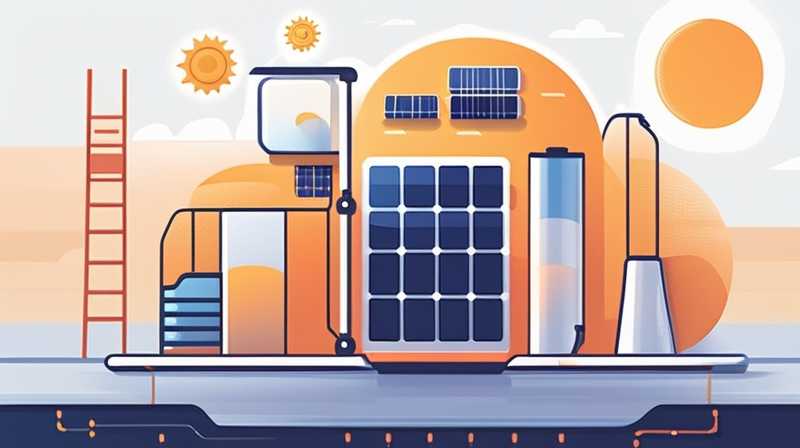
1. When unloading solar energy systems, ensure safety measures are prioritized, understand the components involved, maintain regulatory compliance, and consider energy storage options. Firstly, safety is paramount, as handling electrical components can pose risks if not managed correctly. Ensure all personnel handling the equipment are trained in safety procedures to avoid accidents.
- Proper understanding of the equipment is equally critical. Familiarize yourself with the technical specifications and operational protocols associated with the solar system. Knowledge of how to operate and maintain these systems can greatly enhance their efficiency and longevity.
1. IMPORTANCE OF SAFETY MEASURES IN UNLOADING SOLAR ENERGY
Safety is undeniably the foremost concern when unloading solar energy systems. Proper safety protocols must be established to ensure that all personnel involved are aware of potential hazards and the proper techniques for handling solar components.
When unloading equipment, such as solar panels or inverters, personnel must wear appropriate protective gear, including gloves and goggles. Hazard identification should be a continuous process, examining the environment in which unloading occurs, as uneven surfaces or inclement weather can dramatically increase risks. Conducting a risk assessment prior to unloading can prevent accidents and injuries.
Furthermore, it is vital to have emergency procedures in place in the event of an accident. Training sessions focused on response measures for electrical shocks, falls, or equipment malfunctions can help reinforce a culture of safety among the team. Additionally, employing qualified personnel who are trained in the specifics of unloading solar technology helps further mitigate risks.
2. UNDERSTANDING COMPONENTS OF SOLAR ENERGY SYSTEMS
A thorough understanding of the different components that comprise solar energy systems greatly contributes to effective unloading and installation. Primarily, there are solar panels, inverters, mounting hardware, and wiring that need careful handling. Each element has distinctive characteristics and installation requirements that must be acknowledged during the unloading process.
For instance, solar panels are delicate and can be easily damaged if mishandled. Understanding their fragility and the best practices for carrying, lifting, and positioning them is essential to avoid breaks and scratches, which can substantially impair their function.
Inverters, which are responsible for converting the direct current (DC) produced by solar panels into alternating current (AC) used in homes, encompass complex electronics and should only be placed on a stable and suitable surface during unloading. Moreover, they must be handled with care to prevent any internal damage that could impair their functionality.
3. REGULATORY COMPLIANCE CONSIDERATIONS
Navigating through the myriad of regulations surrounding solar energy systems is paramount for successful unloading and installation. Compliance with local, state, and federal regulations ensures that the systems not only function efficiently but also adhere to safety and environmental standards. Knowledge of these regulations can affect overall efficiency and long-term viability of projects.
Permits are often required for installation, including those for any electrical work involved. This means that individuals must familiarize themselves with relevant code and standards that apply to solar installations in their area. During the unloading phase, verifying that all items comply with these regulations can prevent future legal complications.
Furthermore, commissioning inspections may be mandated, which involve a thorough verification of the equipment and installation before the system can be declared operational. Understanding these requirements not only streamlines the unloading process but also ensures that the project adheres to legal expectations, ultimately contributing to smoother operation post-installation.
4. CONSIDERING ENERGY STORAGE OPTIONS
With rapid advancements in energy storage technology, consideration of battery systems during unloading can offer effective solutions to maximize the use of solar energy. Energy storage allows users to save excess energy produced during peak sunlight hours for use during non-productive hours, greatly enhancing energy consumption efficiency.
Choosing the appropriate energy storage solution depends on various factors, including the user’s energy consumption patterns, the size of the solar installation, and associated costs. Lithium-ion batteries, for instance, have gained popularity due to their longer lifespan and efficiency. However, they require specific handling procedures during unloading and installation to prevent performance issues.
Moreover, it’s important to consider the integration of these storage systems with solar setups, which may require additional components or modifications during unloading. Without proper planning and consideration of energy storage solutions, users may miss out on the full potential of their solar investment.
FAQs
WHAT PRECAUTIONS SHOULD BE TAKEN DURING UNLOADING?
When unloading solar energy equipment, essential precautions include wearing protective gear, ensuring a stable environment free from hazards, conducting team safety briefings, and performing risk assessments. Proper training in handling the specific components involved is also vital, as it minimizes the potential for accidents and equipment damage.
HOW CAN I ENSURE THE LONGEVITY OF MY SOLAR INSTALLATION?
To ensure longevity, regular maintenance checks should be conducted, focusing on cleaning panels, inspecting electrical connections, and examining mounting systems for stability. Additionally, understanding the warranty details and adhering to manufacturer guidelines further facilitates the system’s extended lifespan.
ARE THERE SPECIFIC REGULATIONS FOR SOLAR INSTALLATIONS THAT I NEED TO KNOW?
Yes, regulations vary by location but generally include zoning laws, building codes, and safety standards. It is important to research and ensure compliance with local requirements, as well as any necessary permits for installation. Consulting local authorities or industry professionals can provide more information regarding specific regulations to follow.
In summary, careful attention to safety, a thorough understanding of components, regulatory compliance, and considering energy storage solutions significantly influences the effectiveness and longevity of solar energy installations. Prioritizing safety ensures that personnel remain unharmed, while a deep comprehension of the system components leads to better handling and installation practices. Adherence to regulations keeps installations legally compliant, and planning for energy storage further maximizes the benefits derived from solar energy. These factors combined represent best practices for successfully unloading solar energy systems, paving the way for seamless operations and heightened efficiency.**
Original article by NenPower, If reposted, please credit the source: https://nenpower.com/blog/what-should-you-pay-attention-to-when-unloading-solar-energy/


